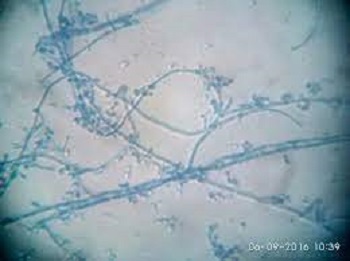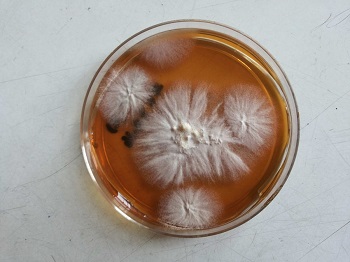Trichophyton tonsurans - Laboratory diagnosis
Laboratory diagnosis of Trichophyton tonsurans
Laboratory diagnosis of Trichophyton tonsurans is done by demonstration of fungal particles such as hyphae, and spores in the specimen.
Samples
Hair
Skin
Nail scrapping
Microscopy
Microscopy (direct microscopy) is performed following KOH preparation to demonstrate fungal particles in the specimen.
The microconidia of Trichophyton tonsurans are abundant in number. They are club-shaped, clavate, to teardrop shaped with flat bottoms that are larger than that of other Trichophyton spp. They are borne on short branches.
Macroconidia of Trichophyton tonsurans are rare but if present is balloon-like in shape and 4-6 cells long.

Trichophyton tonsurans microscopy (Source: ijmrhs)
KOH preparation
KOH preparation is done for laboratory diagnosis of fungal infection.
Procedure
specimen is placed on a clean, grease-free slide and a drop of 10-20% KOH solution is added to it
the sample is covered with a coverslip and immediately viewed under a microscope
the KOH preparation is examined again after 20 mins
in skin or nail specimens, chains of spores or branching hyphae are seen
in the hair specimen, parallel rows of spores are observed inside (endothrix) the hair shaft
* infected hair shaft may also contain air spaces
* skin test does not distinguish active infection
Hair perforation test
Trichophyton tonsurans invade hairs and abundantly sporulate in the hair shaft (endothrix). As a result, the infected hair bursts and curl with hair breaking off near the surface of the scalp, resulting in a black dot on the smooth scalp surface.
Procedure
hair specimens (5-10mm in size) are placed in a Petri dish with 20ml distilled water and autoclaved
sterile 10% yeast extract (2-3 drops) is added to the Petri dish
the hair strands are inoculated with small fragments of test fungi that have been grown on SDA
the inoculated hair strands are incubated at 25°C
for up to a month, the inoculated hair strands are examined weekly after the addition of Lacto Phenol Cotton Blue (LPCB)
Culture
The culture of Trichophyton tonsurans is done as a diagnostic step.
The specimen is inoculated onto Sabouraud’s Dextrose Agar (SDA) incorporated with chloramphenicol and cycloheximide and incubated at 25 to 30°C aerobically for 1 to 3 weeks.
The fungi are identified on the basis of colony morphology, color, pigment production, and the presence/absence of microconidia or macroconidia.
Trichophyton tonsurans colonies are flat, and cream-colored while the reverse side is yellow to tan (yellowish brown) to rust red. It develops into folded colony whose color may range from off-white to grey. Dark pigments may be present which diffuses into the culture medium.
Growth of Trichophyton tonsurans is enhanced in the presence of thiamine which is used for distinguishing it from other species of Trichophyton.
Melanin production by Trichophyton tonsurans can be induced in caffeic acid media in-vitro.
In the early stages, chlamydospore-like structures (CLS) are formed on the reverse side of the culture – when viewed under a light microscope. Chlamydospores, which are asexual spores formed through hyphal modification, mycelia extend into the media to create CLS. The presence of CLS becomes prominent after 5 days of incubation.
Growth of Trichophyton tonsurans is enhanced in the presence of thiamine which is used for distinguishing it from other species of Trichophyton.
BCP-milk solids glucose agar can also be used for the identification of Trichophyton tonsurans. After 7–14 days of incubation at 25 °C, the medium turns from pale blue to purple indicating an alkaline shift due to the release of ammonium from protein hydrolysis.

Trichophyton tonsurans colony (Source: ResearchGate)
Molecular test
The molecular test used for the diagnosis of Trichophyton rubrum are:
PCR-reverse line blot test
real-time PCR test
multiplex PCR test
PCR-ELISA test
MALDI-TOF test
Treatment of Trichophyton tonsurans
Miconazole, Clotrimazole, and Tolnaffate - creams are used for the treatment of mild Trichophyton rubrum infection.
Griseofulvin – oral administration in severe infections for a severe skin infection (4 to 6 weeks) and severe nail infection (1 year).
Prevention of Trichophyton tonsurans
Trichophyton tonsurans can be prevented/controlled by following steps:
avoid moisture build-up in vulnerable areas such as the groin
avoid tight clothing
lose weight if the infected individual is obese
not sharing towels or other fomites
proper cleaning/sanitizing of public showers, bathrooms, dressing rooms, and swimming pools
proper and complete treatment of infected individuals including pet